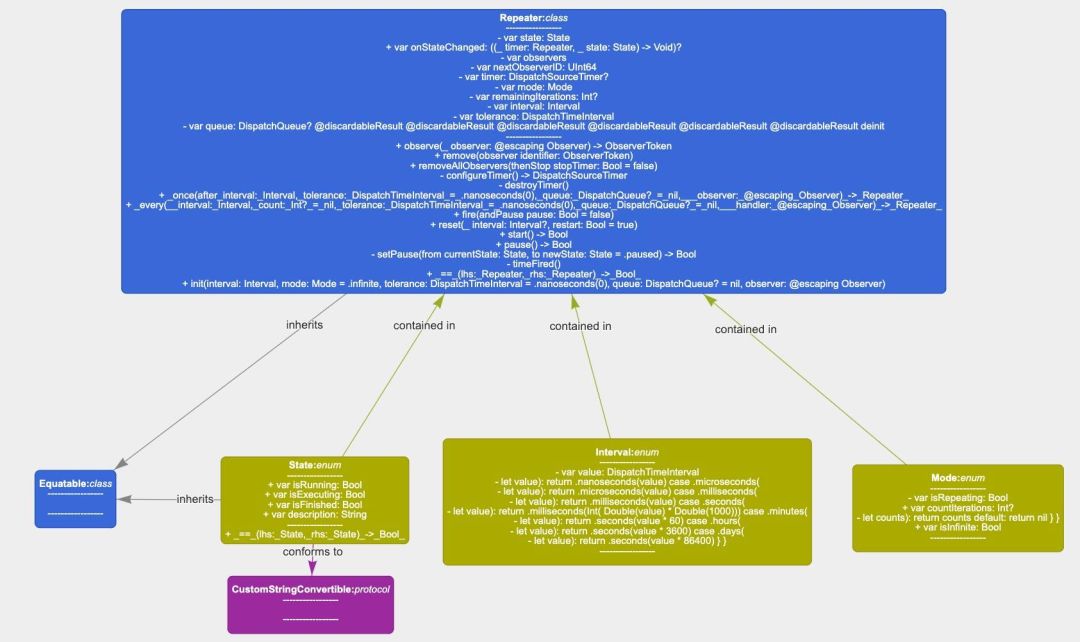源码剖析:探究 Repeat 中 GCD 的应用
作者 | Dylan_王兴彬
简介
Repeat 是 Daniele 开发的一个基于 GCD - Grand Central Dispatch 的轻量定时器,可用于替代 NSTimer,解决其多项不足。
特性
Daniel 着重强调的一些特性:
• 接口简洁明了不冗余
• 避免强引用,解决潜在的内存泄露问题
• 支持注册多个观察者对象监听定时器
• 支持暂停、开始、恢复、重置等操作
• 支持设置多种重复模式
• infinite:无限定时重复
• finite:有限次定时重复
• once:单次定时执行针对以上特性,我们接下来阅读源码时可以着重看看 Daniel 是怎样实现的。
另外,这个库还扩展提供了两个有趣的特性:
• Debouncer: 防抖动,避免方法调用过于密集,总是执行每隔一定时间段内最后一个调用。
• Throttler: 节流阀,确保每隔一定时间段内仅执行一次,并忽略其他调用。
这两个特性对于用过 RxSwift 的开发者肯定不陌生,有了定时器,实现这两者也是顺理成章。
接口的设计、使用与实现
首先,从接口的设计来看看其是否「简洁明了」、「不冗余」,再逐步深入其内部实现。
定时器
注意:Repeater 被设计成和其他许多对象一样,需要被持有来避免被释放。
创建单次定时器
• 接口设计与调用
// 创建单次执行定时器
log("当时只道是寻常")
self.timer = Repeater.once(after: .seconds(5)) { timer in
// 5s 后运行
log("岁月如歌,简单爱一次")
}输出:
2019-10-14 15:12:04 +0000: 当时只道是寻常
2019-10-14 15:12:09 +0000: 岁月如歌,简单爱一次• 单元测试设计
func test_timer_once() {
let exp = expectation(description: "test_once")
let timer = Repeater.once(after: .seconds(5)) { _ in
exp.fulfill()
}
print("Allocated timer \(timer)")
wait(for: [exp], timeout: 6)
}创建有限次重复的定时器
• 接口设计与调用
log("当时只道是寻常")
self.timer = Repeater.every(.seconds(10), count: 5) { timer in
// 每 10s 运行 1 次,5 次后结束
log("岁月如歌,简单爱一次")
}输出:
2019-10-14 15:18:56 +0000: 当时只道是寻常
2019-10-14 15:19:06 +0000: 岁月如歌,简单爱一次
2019-10-14 15:19:16 +0000: 岁月如歌,简单爱一次
2019-10-14 15:19:26 +0000: 岁月如歌,简单爱一次
2019-10-14 15:19:36 +0000: 岁月如歌,简单爱一次
2019-10-14 15:19:46 +0000: 岁月如歌,简单爱一次• 单元测试设计
func test_timer_finiteAndRestart() {
let exp = expectation(description: "test_finiteAndRestart")
var count: Int = 0
var finishedFirstTime: Bool = false
let timer = Repeater(interval: .seconds(0.5), mode: .finite(5)) { _ in
count += 1
print("Iteration #\(count)")
}
timer.onStateChanged = { (_, state) in
print("State changed: \(state)")
if state.isFinished {
if finishedFirstTime == false {
print("Now restart")
timer.start()
finishedFirstTime = true
} else {
exp.fulfill()
}
}
}
timer.start()
wait(for: [exp], timeout: 30)
}单元测试输出:
State changed: running
State changed: executing
Iteration #1
State changed: executing
Iteration #2
State changed: executing
Iteration #3
State changed: executing
Iteration #4
State changed: executing
Iteration #5
State changed: finished
Now restart
State changed: idle/paused
State changed: running
State changed: executing
Iteration #6
State changed: executing
Iteration #7
State changed: executing
Iteration #8
State changed: executing
Iteration #9
State changed: executing
Iteration #10
State changed: finished可以看到,有限次的定时器在次数达到结束后,还可以继续调用 start() 重新开始再次复用,而不必另外创建新实例。
创建无限重复定时器
• 接口设计与调用
log("当时只道是寻常")
let timer = Repeater.every(.seconds(5)) { timer in
// 每 5s 运行一次,直到 timer 生命周期结束
log("岁月如歌,简单爱一次")
}输出:
2019-10-14 15:24:05 +0000: 当时只道是寻常
2019-10-14 15:24:10 +0000: 岁月如歌,简单爱一次
2019-10-14 15:24:15 +0000: 岁月如歌,简单爱一次
2019-10-14 15:24:20 +0000: 岁月如歌,简单爱一次
2019-10-14 15:24:25 +0000: 岁月如歌,简单爱一次
2019-10-14 15:24:30 +0000: 岁月如歌,简单爱一次
2019-10-14 15:24:35 +0000: 岁月如歌,简单爱一次
2019-10-14 15:24:40 +0000: 岁月如歌,简单爱一次
2019-10-14 15:24:45 +0000: 岁月如歌,简单爱一次
...• 单元测试设计
func test_timer_infinite() {
let exp = expectation(description: "test_once")
var count: Int = 0
let timer = Repeater.every(.seconds(0.5), { _ in
count += 1
if count == 20 {
exp.fulfill()
}
})
print("Allocated timer \(timer)")
wait(for: [exp], timeout: 10)
}手动管理计时器
• 接口设计与调用
log("当时只道是寻常")
self.timer = Repeater(interval: .seconds(5), mode: .infinite) { _ in
// 每 5s 运行一次,直到 timer 生命周期结束
log("岁月如歌,简单爱一次")
}
timer.start()输出:
2019-10-14 23:13:46 +0000: 当时只道是寻常
2019-10-14 23:13:51 +0000: 岁月如歌,简单爱一次
2019-10-14 23:13:56 +0000: 岁月如歌,简单爱一次
2019-10-14 23:14:01 +0000: 岁月如歌,简单爱一次
2019-10-14 23:14:06 +0000: 岁月如歌,简单爱一次
2019-10-14 23:14:11 +0000: 岁月如歌,简单爱一次
2019-10-14 23:14:16 +0000: 岁月如歌,简单爱一次
2019-10-14 23:14:21 +0000: 岁月如歌,简单爱一次
2019-10-14 23:14:26 +0000: 岁月如歌,简单爱一次
...其他方法:
• start(): 开始一个已暂停或新创建的定时器
• pause():暂停一个正在运行的定时器
• reset(_ interval: Interval, restart: Bool):重置一个正在运行的定时器,更改时间间隔并重新开始
• fire():额外手动调用一次定时器绑定事件
属性:
• .mode:定时器类型模式
infinite:无限定时重复
finite:有限次定时重复
once:单次定时执行• .remainingIterations:针对 .finite 有限次重复模式结束前的剩余迭代次数
添加或移除多个定时处理
一般而言,初始化定时器时会指定一个处理方法。除此之外, Repeat 的定时器还支持通过observe()额外添加处理方法,并且支持通过token再移除。
// 添加额外的处理监听
let token = timber.observe { _ in
// 额外的新处理
log("一个闹钟能够同时叫醒相爱的两个人。")
}
timer.start()
// 移除
timer.remove(token)观察定时器的状态变化
每个定时器维护着一个状态机,处在以下某个状态:
• .paused:空闲(未被开始过)或已暂停
• .running:正在计时中
• .executing:注册的定时处理方法正在执行
• .finished:计时结束
可以通过.onStateChanged属性添加状态变化回调监听:
timer.onStateChanged = { timer, newState in
// 观察定时器状态变化并做相应处理
log("你永远叫不醒一个装睡的人")
}防抖动器
TBD
节流阀
TBD
源码探究
接下来,进一步看看以上的接口都是如何实现的吧。
文件目录结构
.
├── CHANGELOG.md
├── Configs
│ ├── Repeat.plist
│ └── RepeatTests.plist
├── LICENSE
├── Package.swift
├── README.md
├── Repeat.podspec
├── Repeat.xcodeproj
├── Sources
│ └── Repeat
│ ├── Debouncer.swift
│ ├── Repeater.swift
│ └── Throttler.swift
└── Tests
├── LinuxMain.swift
└── RepeatTests
└── RepeatTests.swift主要文件:
• Sources/Repeat/Repeater.swift:核心定时器实现
• Sources/Repeat/Debouncer.swift:扩展「防抖动器」实现
• Sources/Repeat/Throttler.swift:扩展「节流阀」实现
• Tests/RepeatTests/RepeatTests.swift:单元测试
类图与方法概览
工厂类方法实现以及与 Timer 的异同
在接口设计与使用中可以看到,Repeater 提供了便捷工厂类方法,并且生成的定时器都会「自动开始」,与 Timer 的工厂类方法相似:
/// Alternative API for timer creation with a block.
/// - Experiment: This is a draft API currently under consideration for official import into Foundation as a suitable alternative to creation via selector
/// - Note: Since this API is under consideration it may be either removed or revised in the near future
/// - Warning: Capturing the timer or the owner of the timer inside of the block may cause retain cycles. Use with caution
open class func scheduledTimer(withTimeInterval interval: TimeInterval,
repeats: Bool,
block: @escaping (Timer) -> Void) -> Timer {
let timer = Timer(fire: Date(timeIntervalSinceNow: interval), interval: interval, repeats: repeats, block: block)
CFRunLoopAddTimer(CFRunLoopGetCurrent(), timer._timer!, kCFRunLoopDefaultMode)
return timer
}Tips & Declaration:Timer.swift,注释中有特别提醒注意循环引用的问题。
对比一下 Repeater 的类工厂方法实现:
/// Create and schedule a timer that will call `handler` once after the specified time.
///
/// - Parameters:
/// - interval: interval delay for single fire
/// - queue: destination queue, if `nil` a new `DispatchQueue` is created automatically.
/// - observer: handler to call when timer fires.
/// - Returns: timer instance
@discardableResult
public class func once(after interval: Interval,
tolerance: DispatchTimeInterval = .nanoseconds(0),
queue: DispatchQueue? = nil,
_ observer: @escaping Observer) -> Repeater {
let timer = Repeater(interval: interval, mode: .once, tolerance: tolerance, queue: queue, observer: observer)
timer.start()
return timer
}
/// Create and schedule a timer that will fire every interval optionally by limiting the number of fires.
///
/// - Parameters:
/// - interval: interval of fire
/// - count: a non `nil` and > 0 value to limit the number of fire, `nil` to set it as infinite.
/// - queue: destination queue, if `nil` a new `DispatchQueue` is created automatically.
/// - handler: handler to call on fire
/// - Returns: timer
@discardableResult
public class func every(_ interval: Interval,
count: Int? = nil,
tolerance: DispatchTimeInterval = .nanoseconds(0),
queue: DispatchQueue? = nil,
_ handler: @escaping Observer) -> Repeater {
let mode: Mode = (count != nil ? .finite(count!) : .infinite)
let timer = Repeater(interval: interval, mode: mode, tolerance: tolerance, queue: queue, observer: handler)
timer.start()
return timer
}两者的做法大相径庭,都是创建一个定时器实例并「自动开始」,只是开始的方式由于内部固有的实现方式有所不同:
• Timer 依赖 RunLoop,需要将创建定时器生成的 CFRunLoopTimer 加入当前 Runloop
• Repeater 依赖 GCD 的 DispatchSourceTimer,start 内部会调 DispatchSourceTimer 的 实例方法resume
初始化方法
/// Initialize a new timer.
///
/// - Parameters:
/// - interval: interval of the timer
/// - mode: mode of the timer
/// - tolerance: tolerance of the timer, 0 is default.
/// - queue: queue in which the timer should be executed; if `nil` a new queue is created automatically.
/// - observer: observer
public init(interval: Interval, mode: Mode = .infinite, tolerance: DispatchTimeInterval = .nanoseconds(0), queue: DispatchQueue? = nil, observer: @escaping Observer) {
self.mode = mode
self.interval = interval
self.tolerance = tolerance
self.remainingIterations = mode.countIterations
self.queue = (queue ?? DispatchQueue(label: "com.repeat.queue"))
self.timer = configureTimer()
self.observe(observer)
}初始化方法参数列表:
• interval:定时器时间间隔
• mode:定时器重复模式,默认为.infinite,无限重复
• tolerance:容许误差(这个最终是作为DispatchSourceTimer的leeway参数)
• queue:指定定时器运行的队列,若未指定,则自动创建默认队列
• observer:定时器运行的回调方法
创建并配置 DispatchSourceTimer
private func configureTimer() -> DispatchSourceTimer {
let associatedQueue = (queue ?? DispatchQueue(label: "com.repeat.\(NSUUID().uuidString)"))
let timer = DispatchSource.makeTimerSource(queue: associatedQueue)
let repeatInterval = interval.value
let deadline: DispatchTime = (DispatchTime.now() + repeatInterval)
if self.mode.isRepeating {
timer.schedule(deadline: deadline, repeating: repeatInterval, leeway: tolerance)
} else {
timer.schedule(deadline: deadline, leeway: tolerance)
}
timer.setEventHandler { [weak self] in
if let unwrapped = self {
unwrapped.timeFired()
}
}
return timer
}• 根据初始化传入的参数,初始化并配置一个 DispatchSourceTimer
• 将 DispatchSourceTimer 的处理回调通过timeFired方法处理
这一段代码是 Repeat 中 GCD 的应用关键,Repeat 的核心计时器即是 DispatchSourceTimer,进一步封装并屏蔽部分复杂逻辑,以提供简洁易用的接口。
计时器启动、暂停与重置
/// Reset the state of the timer, optionally changing the fire interval.
///
/// - Parameters:
/// - interval: new fire interval; pass `nil` to keep the latest interval set.
/// - restart: `true` to automatically restart the timer, `false` to keep it stopped after configuration.
public func reset(_ interval: Interval?, restart: Bool = true) {
if self.state.isRunning {
self.setPause(from: self.state)
}
// For finite counter we want to also reset the repeat count
if case .finite(let count) = self.mode {
self.remainingIterations = count
}
// Create a new instance of timer configured
if let newInterval = interval {
self.interval = newInterval
} // update interval
self.destroyTimer()
self.timer = configureTimer()
self.state = .paused
if restart {
self.timer?.resume()
self.state = .running
}
}
/// Start timer. If timer is already running it does nothing.
@discardableResult
public func start() -> Bool {
guard self.state.isRunning == false else {
return false
}
// If timer has not finished its lifetime we want simply
// restart it from the current state.
guard self.state.isFinished == true else {
self.state = .running
self.timer?.resume()
return true
}
// Otherwise we need to reset the state based upon the mode
// and start it again.
self.reset(nil, restart: true)
return true
}
/// Pause a running timer. If timer is paused it does nothing.
@discardableResult
public func pause() -> Bool {
guard state != .paused && state != .finished else {
return false
}
return self.setPause(from: self.state)
}
/// Pause a running timer optionally changing the state with regard to the current state.
///
/// - Parameters:
/// - from: the state which the timer should only be paused if it is the current state
/// - to: the new state to change to if the timer is paused
/// - Returns: `true` if timer is paused
@discardableResult
private func setPause(from currentState: State, to newState: State = .paused) -> Bool {
guard self.state == currentState else {
return false
}
self.timer?.suspend()
self.state = newState
return true
}• start方法主要是做状态判断并进行相应处理返回结果,其开始计时的核心是调用内部 DispatchSourceTimer 的 resume 方法
• pause 方法类似,调用的是 suspend 方法,并更新内部计时器状态
• reset 重置内部的一些计时标志位的同时,会将内部的 DispatchSourceTimer 销毁并新建
添加或移除多个定时观察者
/// List of the observer of the timer
private var observers = [ObserverToken: Observer]()
/// Next token of the timer
private var nextObserverID: UInt64 = 0
/// Add new a listener to the timer.
///
/// - Parameter callback: callback to call for fire events.
/// - Returns: token used to remove the handler
@discardableResult
public func observe(_ observer: @escaping Observer) -> ObserverToken {
var (new, overflow) = self.nextObserverID.addingReportingOverflow(1)
if overflow { // you need to add an incredible number of offset...sure you can't
self.nextObserverID = 0
new = 0
}
self.nextObserverID = new
self.observers[new] = observer
return new
}
/// Remove an observer of the timer.
///
/// - Parameter id: id of the observer to remove
public func remove(observer identifier: ObserverToken) {
self.observers.removeValue(forKey: identifier)
}• 通过字典储存观察者回调事件,通过 UInt64 的 ObserverToken 来进行标识
• 观察者数量上限控制在 UInt64 的溢出范围
定时事件触发
/// Called when timer is fired
private func timeFired() {
self.state = .executing
if case .finite = self.mode {
self.remainingIterations! -= 1
}
// dispatch to observers
self.observers.values.forEach { $0(self) }
// manage lifetime
switch self.mode {
case .once:
// once timer's lifetime is finished after the first fire
// you can reset it by calling `reset()` function.
self.setPause(from: .executing, to: .finished)
case .finite:
// for finite intervals we decrement the left iterations count...
if self.remainingIterations! == 0 {
// ...if left count is zero we just pause the timer and stop
self.setPause(from: .executing, to: .finished)
}
case .infinite:
// infinite timer does nothing special on the state machine
break
}
}• timeFired 方法被两个地方调用,一个是配置DispatchSourceTimer时设置的事件回调,一个是对外暴露的手动触发方法 fire(andPause:) 中
• 根据计时模式更新计时器状态,计时模式的实现核心逻辑即在于此 遍历所有观察者逐个回调,触发真正的计时器绑定事件
总结
致谢与参考
文中涉及源码大部分来自开源社区,以及部分其他文献参考。
•Repeat by Daniele Margutti, under The MIT License (MIT) https://github.com/malcommac/Repeat
• swift-corelibs-foundation Licensed under Apache License v2.0 with Runtime Library Exception https://github.com/apple/swift-corelibs-foundation
• A Background Repeating Timer in Swift by Daniel Galasko https://medium.com/over-engineering/a-background-repeating-timer-in-swift-412cecfd2ef9


